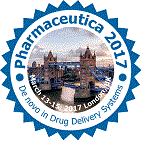
Sharif Abdelghany
University of Jordan, Jordan
Title: PLGA nanoparticles entrapping amikacin and moxifloxacin as a potential host-directed agent therapy for multidrug resistant tuberculosis
Biography
Biography: Sharif Abdelghany
Abstract
Polymeric nanoparticles have been widely investigated as a controlled release drug delivery platform for the treatment of tuberculosis (TB). These nanoparticles were also readily internalised into macrophages, leading to high intracellular drug concentration. In this study two anti-TB drugs, amikacin and moxifloxacin were encapsulated into PLGA nanoparticles. The novelty of this work appears in: (1) the efficient encapsulation of two hydrophilic second-line anti-TB drugs,and (2) intramacrophage delivery of this synergistic combination potentially for rapid treatment of multi-drug resistant TB (MDR-TB). Two water-oil-water (w/o/w) emulsion strategies were employed in this study: (1) alginate coated PLGA nanoparticles, and (2) alginate entrapped PLGA nanoparticles. The average particle size and polydispersity index (PDI) of the alginate coated PLGA nanoparticles were found to be unfavourably high with values of 640 ± 32 nm and 0.63 ± 0.09, respectively. In contrast, the alginate entrapped PLGA nanoparticles were within the desirable particle size range of 282 - 315 nm and the PDI was 0.08 - 0.16, and therefore were chosen for subsequent studies. Alginate entrapped PLGA nanoparticles yielded a drug loading of over 10 µg/mg powder for amikacin, and more than 5 µg/mg for moxifloxacin and entrapment efficiencies range of approximately 25-31% for moxifloxacin and 51-59% for amikacin. To study macrophage uptake efficiency, the nanoparticles of alginate entrapped nanoparticle formulation were loaded with acridine orange as a marker, seeded to THP-1 derived macrophages and viewed under confocal microscopy. The particles were readily internalised into the macrophages and highly concentrated in the nucleus region. Furthermore, the anti-mycobacterial activity of the drug-loaded particles was evaluated using M. tuberculosis-infected macrophages, which revealed a significant reduction (4 log reduction) of viable bacterial count compared to the untreated group. In conclusion, the amikacin-moxifloxacin alginate entrapped PLGA nanoparticles are promising for further in vivo studies. Particle internalisation of acridine orange loaded PLGA nanoparticles by THP-1 derived macrophages using confocal microscopy. The cells were treated with acridine orange loaded nanoparticles at two different concentrations of: (A) 100 µg/mL and (B) 10 µg/mL, and (C-D) PBS cells. (E) The fluorescence intensity of acridine orange loaded nanoparticles and DAPI with increasing Z dimension (corresponds to the intensity in different layers of the macrophage cell). The green color corresponds to the distribution of nanoparticles in the cytosol of THP-1 cells. The blue colour corresponds to the DAPI stained nucleus.

